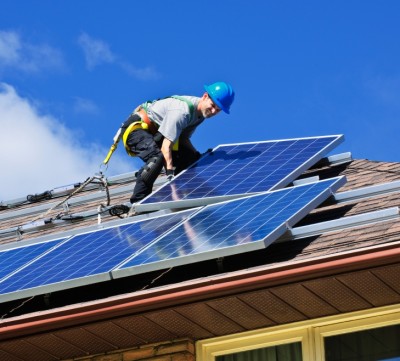In my last post, I noted the disdain U.S. elites feel for the grubby-but-necessary politics of clean energy deployment. It’s all well and good to advocate for sweeping macroeconomic solutions to carbon pollution, but there are all sorts of proximate battles being fought on the ground today. They’d be easier to win if pundits like Fareed Zakaria would weigh in on the right side.
As an illustration of what I’m talking about, let me describe three current projects that together could put the U.S. on course for a major solar expansion.
 SolarStrong
SolarStrong
Start with an announcement a few weeks ago that should have gotten more press. The military has contracted with SolarCity for a five-year, $1 billion project called SolarStrong to put solar panels on the roofs of 160,000 housing complexes on 124 military bases in 33 states. It would be the single largest residential rooftop solar program in history and, in a stroke, double the amount of installed rooftop solar in the U.S. In the process, the company estimates it would create 6,000 jobs over the next five years, many of which would go to military veterans and their family members, who are experiencing some of the nation’s highest unemployment rates.
On Sept. 2, the Department of Energy provisionally offered a $275 million loan guarantee to lower the cost of capital for the project and help it expand into states that don’t have good renewable energy incentives and thus haven’t had much renewable energy investment — like Alabama, Louisiana, and Mississippi.
Now that loan guarantee is in jeopardy, in part, SolarCity says, because DOE simply doesn’t have time to complete its work by the Sept. 30 deadline at which point the Section 1705 loan-guarantee program will expire (unless Congress renews it, which seems highly unlikely at this point). DOE is grappling with “increased documentation requirements that are the result of the current congressional investigation into the Solyndra bankruptcy.” That’s what SolarCity says in a letter [PDF] sent to the House Energy and Commerce Committee on Sept. 23, pleading for an extension of the deadline.
The loan guarantee “covers less than a quarter of the project,” Jonathan Bass of SolarCity told me. “We would still pursue it [but] it would probably be scaled back a bit.”
What a ridiculous outcome that would be: a virtually risk-free investment by taxpayers in clean energy and domestic jobs for veterans, stifled by red tape.
Enough with the carbon tax calls — Tom Friedman should write about this!
SunShot Initiative
It’s not as big as the loan-guarantee program and it doesn’t get as much press, but the Department of Energy has an extremely cool program going called the SunShot Initiative. Its goal is to reduce the cost of installed solar systems by 75 percent by the end of the decade, making solar competitive with coal.
It’s pursuing that goal with a broad array of small investments in innovative companies. Recipients of SunShot money aren’t just in solar tech, they are also working on reducing the paperwork required to site and build projects, or to rationalize code requirements and put them in an online database, or to give customers easier access to financing. The nuts-and-bolts stuff.
Despite the hoo-ha over Solyndra, the Sunshot Initiative is going strong. It’s doing just the kind of investment in innovation that all the hot energy thinkers say they want. Nonetheless, it’s a little-known, little-celebrated, and underfunded program. A little recognition from, say, Bill Gates would do SunShot wonders!
10 Million Solar Roofs
Finally, Vermont Sen. Bernie Sanders (I) has long been pushing a bill called the “10 Million Solar Roofs Act.” Its goal is to reduce permitting and installation costs of rooftop solar, to put the U.S. on a trajectory to install 10 million rooftop systems by 2020. It would award competitive grants to communities that streamlined their permit process and companies that developed new tools and practices for installation.
The 2011 version has been made over to incorporate the SunShot Initiative within its larger program. More significantly, it has picked up a few notable cosponsors: Jeff Bingaman (D-N.M.), who chairs the Senate Energy Committee, and John Boozman (R-Ark.), a freshman Republican beloved of the Tea Party and, at least historically, no friend of the environment. Boozman was won over by the bill’s promise of jobs, energy independence, and fiscal rectitude (it requires no new money, just borrows from elsewhere in DOE).
A Republican sponsor of an ambitious solar bill. You’d think that would make news and maybe even shake things up a bit in Congress. But it’s barely been noted. Where’s Fareed Zakaria when you need him?
Add ’em up
A few things to note about these three items. First, none are bets on advanced technology manufacturing, like Solyndra was. They’re not nearly as risky. They’re all about driving down costs and ramping up demand. They will also create jobs that “can’t be outsourced,” as they say, for all sorts of domestic service industries. They will accelerate solar uptake, scale up the solar sale, installation, and leasing industries, and make the country more energy secure.
And they will all reinforce one another — driving down costs will increase adoption, increasing adoption will drive down costs — making solar advocates out of hundreds of thousands, eventually millions, of Americans.
These programs are battling for attention and money in a toxic political environment. They are not grand wonky schemes or ultimate solutions, but they are promising points of light in an otherwise dark political night. In a grad school bull session, you could probably think of plenty of policies that would achieve similar goals in more economically efficient ways. (For my part, I’d like feed-in tariffs like Germany’s.)
But this isn’t a grad school bull session, it’s politics, and for whatever reasons, these are the tools at hand. These are the battles being fought. It would be nice if people like Daniel Yergin, Fareed Zakaria, and the rest of America’s elite cognoscenti would occasionally descend from their Olympian heights and help fight them.




